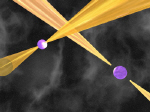 |
|
|
| ||
|
First double pulsar comes into
view The first ever double pulsar has been discovered by an international team of astronomers from the UK, Australia, Italy and the US. The discovery will allow new tests of general relativity and will also enable the magnetosphere of a pulsar to be studied for the first time (A G Lyne et al. 2004 Sciencexpress 1094645)
Pulsars are extremely dense neutron stars that are a million times more massive than the earth, yet measure just tens of kilometres across. They also rotate rapidly, sending out beams of radio waves across space, like a lighthouse. Radio telescopes detect pulsars as a regular train of pulses as the beams sweep over Earth. Precise timing measurements on binary pulsars - systems in which a pulsar orbits another object - can be used in tests of Einstein's general theory of relativity. The double pulsar story started when Andrew Lyne of the Jodrell Bank Observatory at Manchester University and co-workers discovered pulsar J0737-3039A with the 64-metre Parkes radio telescope in December 2003. They found that it was rotating with a period of 23 milliseconds as it orbited around another neutron star (Nature 426 531). Now, new measurements with the Parkes telescope and the 76-metre Lovell radio telescope at Jodrell Bank have revealed that this neutron star is also a pulsar, with a period of 2.77 seconds. "Having two observable pulsars in the same binary system will allow different and much more precise tests of different theories of gravity than have been possible before," Lyne told PhysicsWeb. The team has already been able to measure the ratio of the masses of the two objects - a feat not possible for binaries until now. General relativity predicts that the two pulsars should they slowly spiral towards each other with a characteristic "wobble" in their motion. Moreover, by studying what happens to the radiation from the millisecond pulsar as it passes behind its companion it will be possible to probe the outer atmosphere, or magnetosphere, of this second pulsar in detail. "And now we know that such systems exist, we will also continue our quest to find more systems like it," added Lyne. Author
|
|
||||||||||||||||||||||||||||||||||||||||||||||||||||||||||||||||||||||||||||||||||||||||||||||||||||||||||||||||||||||||||||||||||||||||||||||||||||||||||||||||||||||||||||||||||||||||||||||||||||||||||||||||||||||||||||||||||||||||||||||||||||||||||||||||||||||||||||||||||||||||||||||||||||||||||||||||||
 | ||||||||||||||||||||||||||||||||||||||||||||||||||||||||||||||||||||||||||||||||||||||||||||||||||||||||||||||||||||||||||||||||||||||||||||||||||||||||||||||||||||||||||||||||||||||||||||||||||||||||||||||||||||||||||||||||||||||||||||||||||||||||||||||||||||||||||||||||||||||||||||||||||||||||||||||||||||
|
Home | News | Physics World | PhysicsJobs | Resources | Events | Best of PhysicsWeb Tel +44 (0)117 929 7481 | Fax +44 (0)117 925 1942 | E-mail info@physicsweb.org | ||||||||||||||||||||||||||||||||||||||||||||||||||||||||||||||||||||||||||||||||||||||||||||||||||||||||||||||||||||||||||||||||||||||||||||||||||||||||||||||||||||||||||||||||||||||||||||||||||||||||||||||||||||||||||||||||||||||||||||||||||||||||||||||||||||||||||||||||||||||||||||||||||||||||||||||||||||
